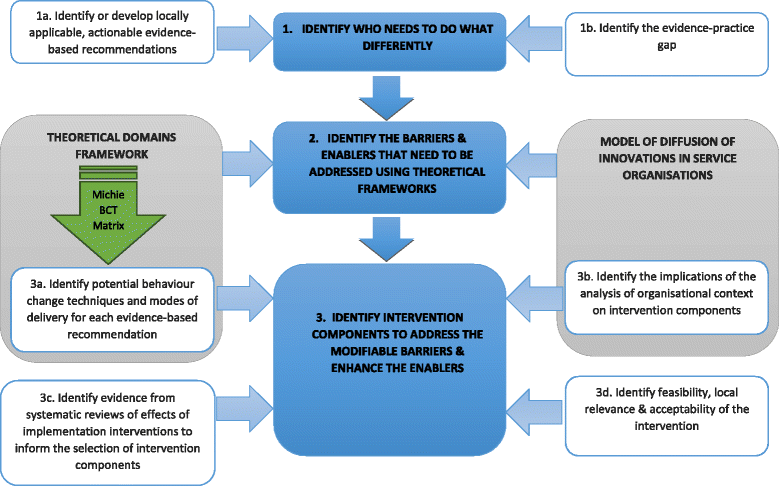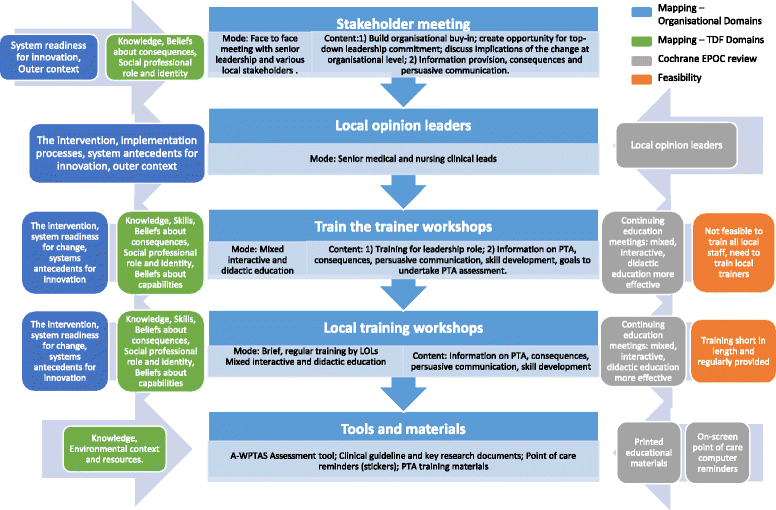Developing a targeted, theory-informed implementation intervention using two theoretical frameworks to address health professional and organisational factors: a case study to improve the management of mild traumatic brain injury in the emergency department
- PMID: 26003785
- PMCID: PMC4446082
- DOI: 10.1186/s13012-015-0264-7
Developing a targeted, theory-informed implementation intervention using two theoretical frameworks to address health professional and organisational factors: a case study to improve the management of mild traumatic brain injury in the emergency department
Abstract
Background: Despite the availability of evidence-based guidelines for the management of mild traumatic brain injury in the emergency department (ED), variations in practice exist. Interventions designed to implement recommended behaviours can reduce this variation. Using theory to inform intervention development is advocated; however, there is no consensus on how to select or apply theory. Integrative theoretical frameworks, based on syntheses of theories and theoretical constructs relevant to implementation, have the potential to assist in the intervention development process. This paper describes the process of applying two theoretical frameworks to investigate the factors influencing recommended behaviours and the choice of behaviour change techniques and modes of delivery for an implementation intervention.
Methods: A stepped approach was followed: (i) identification of locally applicable and actionable evidence-based recommendations as targets for change, (ii) selection and use of two theoretical frameworks for identifying barriers to and enablers of change (Theoretical Domains Framework and Model of Diffusion of Innovations in Service Organisations) and (iii) identification and operationalisation of intervention components (behaviour change techniques and modes of delivery) to address the barriers and enhance the enablers, informed by theory, evidence and feasibility/acceptability considerations. We illustrate this process in relation to one recommendation, prospective assessment of post-traumatic amnesia (PTA) by ED staff using a validated tool.
Results: Four recommendations for managing mild traumatic brain injury were targeted with the intervention. The intervention targeting the PTA recommendation consisted of 14 behaviour change techniques and addressed 6 theoretical domains and 5 organisational domains. The mode of delivery was informed by six Cochrane reviews. It was delivered via five intervention components : (i) local stakeholder meetings, (ii) identification of local opinion leader teams, (iii) a train-the-trainer workshop for appointed local opinion leaders, (iv) local training workshops for delivery by trained local opinion leaders and (v) provision of tools and materials to prompt recommended behaviours.
Conclusions: Two theoretical frameworks were used in a complementary manner to inform intervention development in managing mild traumatic brain injury in the ED. The effectiveness and cost-effectiveness of the developed intervention is being evaluated in a cluster randomised trial, part of the Neurotrauma Evidence Translation (NET) program.
Figures
Similar articles
-
Development of a theory-informed implementation intervention to improve the triage, treatment and transfer of stroke patients in emergency departments using the Theoretical Domains Framework (TDF): the T3 Trial.Implement Sci. 2017 Jul 17;12(1):88. doi: 10.1186/s13012-017-0616-6. Implement Sci. 2017. PMID: 28716152 Free PMC article. Clinical Trial.
-
Evaluation of a targeted, theory-informed implementation intervention designed to increase uptake of emergency management recommendations regarding adult patients with mild traumatic brain injury: results of the NET cluster randomised trial.Implement Sci. 2019 Jan 17;14(1):4. doi: 10.1186/s13012-018-0841-7. Implement Sci. 2019. PMID: 30654826 Free PMC article. Clinical Trial.
-
The Many Organisational Factors Relevant to Planning Change in Emergency Care Departments: A Qualitative Study to Inform a Cluster Randomised Controlled Trial Aiming to Improve the Management of Patients with Mild Traumatic Brain Injuries.PLoS One. 2016 Feb 4;11(2):e0148091. doi: 10.1371/journal.pone.0148091. eCollection 2016. PLoS One. 2016. PMID: 26845772 Free PMC article.
-
Prospective application of theoretical implementation frameworks to improve health care in hospitals - a systematic review.BMC Health Serv Res. 2023 Jun 9;23(1):607. doi: 10.1186/s12913-023-09609-y. BMC Health Serv Res. 2023. PMID: 37296453 Free PMC article.
-
Executive summary: interventions to improve quality in the crowded emergency department.Acad Emerg Med. 2011 Dec;18(12):1229-33. doi: 10.1111/j.1553-2712.2011.01228.x. Acad Emerg Med. 2011. PMID: 22168183
Cited by
-
Identifying barriers and enablers to rigorous conduct and reporting of preclinical laboratory studies.PLoS Biol. 2023 Jan 5;21(1):e3001932. doi: 10.1371/journal.pbio.3001932. eCollection 2023 Jan. PLoS Biol. 2023. PMID: 36603053 Free PMC article.
-
Facilitating Guideline Implementation in Primary Health Care Practices.J Prim Care Community Health. 2020 Jan-Dec;11:2150132720916263. doi: 10.1177/2150132720916263. J Prim Care Community Health. 2020. PMID: 32390499 Free PMC article.
-
A micro costing analysis of the development of a primary care intervention to improve the uptake of diabetic retinopathy screening.Implement Sci. 2021 Feb 10;16(1):17. doi: 10.1186/s13012-021-01085-4. Implement Sci. 2021. PMID: 33568201 Free PMC article.
-
Development of an Implementation Strategy Tailored to Deliver Evidence-Based and Person-Centred Nursing Care for Patients with Community-Acquired Pneumonia: An Intervention Mapping Approach.Healthcare (Basel). 2023 Dec 22;12(1):32. doi: 10.3390/healthcare12010032. Healthcare (Basel). 2023. PMID: 38200938 Free PMC article.
-
System-Level Action Required for Wide-Scale Improvement in Quality of Primary Health Care: Synthesis of Feedback from an Interactive Process to Promote Dissemination and Use of Aggregated Quality of Care Data.Front Public Health. 2016 May 4;4:86. doi: 10.3389/fpubh.2016.00086. eCollection 2016. Front Public Health. 2016. PMID: 27200338 Free PMC article.
References
-
- Michie S, Johnston M, Francis JJ, Hardeman W, Eccles M. From theory to intervention: mapping theoretically derived behavioural determinants to behaviour change techniques. Appl Psychol. 2008;57:660–80. doi: 10.1111/j.1464-0597.2008.00341.x. - DOI
-
- WIDER recommendations to improve reporting of the content of behaviour change interventions. [http://www.implementationscience.com/content/supplementary/1748-5908-7-7...]
Publication types
MeSH terms
LinkOut - more resources
Full Text Sources
Other Literature Sources



